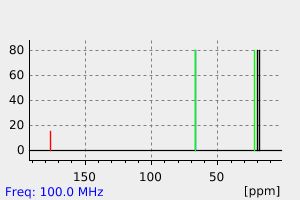propyl (2R)-2-hydroxypropanoate | 53651-70-0
中文名称
——
中文别名
——
英文名称
propyl (2R)-2-hydroxypropanoate
英文别名
(R)-(+)-n-propyl lactate;(R)-n-propyl lactate;(R)-propyl lactate;n-propyl D-lactate;D-propyl lactate;d(+)-lactic acid propyl ester;(+)-Propyl lactate
CAS
53651-70-0
化学式
C6H12O3
mdl
——
分子量
132.159
InChiKey
ILVGAIQLOCKNQA-RXMQYKEDSA-N
BEILSTEIN
——
EINECS
——
-
物化性质
-
计算性质
-
ADMET
-
安全信息
-
SDS
-
制备方法与用途
-
上下游信息
-
文献信息
-
表征谱图
-
同类化合物
-
相关功能分类
-
相关结构分类
计算性质
-
辛醇/水分配系数(LogP):0.8
-
重原子数:9
-
可旋转键数:4
-
环数:0.0
-
sp3杂化的碳原子比例:0.83
-
拓扑面积:46.5
-
氢给体数:1
-
氢受体数:3
反应信息
-
作为反应物:描述:propyl (2R)-2-hydroxypropanoate 、 对甲苯磺酰氯 在 三乙胺 作用下, 以 甲苯 为溶剂, 反应 12.0h, 生成 propyl (2R)-2-[(4-methylbenzenesulfonyl)oxy]propanoate参考文献:名称:S-2-(4-甲氧基苯氧基)丙酸钠的制备方法摘要:本发明公开了一种高光学活性甜味抑制剂S‑2‑(4‑甲氧基苯氧基)丙酸钠的制备方法。本发明通过D‑取代乳酸酯与取代苯磺酰氯反应生成对应的R‑取代磺酰基乳酸酯;然后将所得到的R‑取代磺酰基乳酸酯与对甲氧基苯酚盐在溶剂下反应生成S‑2‑(4‑甲氧基苯氧基)丙酸酯;将所得到的酯水解、酸化后,再与含钠离子的碱反应,即得。本发明首次研发出S‑2‑(4‑甲氧基苯氧基)丙酸钠的制备方法。所得到的S‑2‑(4‑甲氧基苯氧基)丙酸钠光学纯度高;感官法测定S‑2‑(4‑甲氧基苯氧基)丙酸钠较外消旋体对蔗糖有更好的甜味抑制效果,可以减少外消旋体中非有效成分R型在人体中的代谢负担,并且消除了对人体的潜在危害。公开号:CN104725219B
-
作为产物:描述:参考文献:名称:Reduction of carbonyl compounds via hydrosilylation. 3. Asymmetric reduction of keto esters via hydrosilylation catalyzed by a rhodium complex with chiral phosphine ligands摘要:DOI:10.1021/jo00430a001
文献信息
-
Poly(3-hydroxybutyrate)-depolymerase from <i>Pseudomonas lemoignei</i>: Catalysis of Esterifications in Organic Media作者:Ajay Kumar、R. A. Gross、D. JendrossekDOI:10.1021/jo000814y日期:2000.11.1lemoignei in organic media to catalyze ester-forming reactions was investigated. The effect of different organic solvents (benzene-d(6), cyclohexane-d(12), and acetonitrile-d(3)) on the activity of the PHB-depolymerase toward propylation of L-lactide was studied. A significant difference in the catalytic rate was observed as a function of solvent polarity. The selectivity of the PHB-depolymerase (P. lemoignei)非水介质中的脂肪酶催化被认为是有机和最近的聚合物合成中的有力工具。即使目前已知的多羟基链烷酸酯(PHA)解聚酶均不具有脂肪酶活性,但它们的催化中心确实类似于脂肪酶。由于以上原因,研究了在有机介质中使用来自肺炎单胞菌的聚(3-羟基丁酸酯),PHB,解聚酶催化酯形成反应的潜力。研究了不同的有机溶剂(苯-d(6),环己烷-d(12)和乙腈-d(3))对PHB解聚酶对L-丙交酯丙基化的活性的影响。观察到催化速率的显着差异是溶剂极性的函数。PHB解聚酶的选择性(P. 已使用PHB解聚酶(Lemoignei)在有机物中研究了催化ε-己内酯,δ-丁内酯,γ-丁内酯,D,L,内消旋和外消旋丙交酯等一系列不同内酯的丙基化反应。溶剂。观察到这些内酯的反应性以及立体化学上不同的线性乳酸二聚体的选择性水解的重要差异。而且,研究了PHB解聚酶催化ε-己内酯和碳酸三亚甲基酯的无溶剂聚合的能力。还观察到了立体化学上不同
-
The asymmetric hydrogenation of α-keto esters catalyzed by rhodium(I) complexes with chiral diphosphine ligands. On the catalytic cycles and the mechanism of asymmetric induction作者:Iwao Ojima、Tetsuo KogureDOI:10.1016/s0022-328x(00)90008-1日期:1980.8ketopantoyl lactone catalyzed by rhodium complexes with (—) DIOP and BPPM were carried out under a variety of conditions. It was found that i) the Schrock-Osborn mechanism was not operative in these reactions at all since no acceleration of the reaction rate by the addition of water (1%) was observed, ii) there was a clear difference between cationic and neutral (in situ) rhodium catalysts in their
-
Lipase-Catalyzed Oligomerization and Hydrolysis of Alkyl Lactates: Direct Evidence in the Catalysis Mechanism That Enantioselection Is Governed by a Deacylation Step作者:Hitomi Ohara、Akihisa Onogi、Masafumi Yamamoto、Shiro KobayashiDOI:10.1021/bm1003674日期:2010.8.9l-lactates in similar conditions. Lipase-catalyzed hydrolysis of alkyl d- and l-lactates was also examined, revealing that the hydrolysis took place for both d- and l-lactates, although l-lactates proceeded a couple of times slower. The hydrolysis results clearly demonstrate that the lipase catalysis mechanism involves an acyl-enzyme intermediate (EM) formation via the acylation step from both d- and首次研究了脂肪酶催化的d-和l-乳酸烷基酯单体(分别为RDLA和RLLA)的低聚反应。已经发现,低聚仅对d-乳酸酯发生对映选择性,从而通过使用伯C1-C8烷基和仲-丁基作为d-乳酸酯单体,以良好至高产率使低聚物达到乳酸(LA)的七聚体。在类似条件下,所有l-乳酸均未发生反应。烷基的脂肪酶催化的水解d -和升-LActates还检查,揭示了水解发生两个d -和升-l乳酸盐,尽管l-乳酸盐进行的速度慢了几倍。水解结果清楚地表明,脂肪酶的催化机制涉及通过d-和l-乳酸的酰化步骤形成酰基酶中间体(EM),作为速率确定步骤,随后的脱酰步骤是水的亲核攻击。到EM发生,以产生免费的LA。另一方面,在d-乳酸酯的低聚中,脱酰基步骤仅在sec - d内允许单体的仲醇基团或向EM传播的链端进攻的仲醇基团。-醇基团得到一个-LA-单元延长的低聚物。l-乳酸盐形成EM ; 然而,同时与随后的脱酰反应秒-升-和仲-
-
Enantioselective hydrogenation of pyruvates over polymer-stabilized and supported platinum nanoclusters作者:Xiaobin Zuo、Hanfan Liu、Dawei Guo、Xiaozhen YangDOI:10.1016/s0040-4020(99)00415-9日期:1999.6cinchonidine-modified enantioselective hydrogenation of pyruvates has been studied over polyvinylpyrrolidone-stabilized platinum (PVP-Pt) and the corresponding alumina-supported platinum (Al2O3-Pt) clusters. It is shown that the catalysts with particle size less than 2.0 nm demonstrate > 90% enantioselectivity in favor of (R)-lactates. The solvent effect is similar to that over the conventional supported platinum catalyst
-
Highly Effective Catalytic Asymmetric Hydrogenations of α-Keto Esters and an α-Keto Acetal with New Neutral Chiral Pyrrolidinebisphosphine-Rhodium Complexes作者:Hisashi Takahashi、Toshiaki Morimoto、Kazuo AchiwaDOI:10.1246/cl.1987.855日期:1987.5.5Synthesis of new chiral pyrrolidinebisphosphine–rhodium complexes and their application to the asymmetric hydrogenations of α-keto esters and an α-keto acetal are described. Among them, MCCPM-Rh gave the highest optical yield (87%) of the α-hydroxy ester and MCPM-Rh gave the 75% optical yield of the α-hydroxy acetal at the substrate to catalyst ratio (1000:1).
表征谱图
-
氢谱1HNMR
-
质谱MS
-
碳谱13CNMR
-
红外IR
-
拉曼Raman
-
峰位数据
-
峰位匹配
-
表征信息
同类化合物
(甲基3-(二甲基氨基)-2-苯基-2H-azirene-2-羧酸乙酯)
(±)-盐酸氯吡格雷
(±)-丙酰肉碱氯化物
(d(CH2)51,Tyr(Me)2,Arg8)-血管加压素
(S)-(+)-α-氨基-4-羧基-2-甲基苯乙酸
(S)-阿拉考特盐酸盐
(S)-赖诺普利-d5钠
(S)-2-氨基-5-氧代己酸,氢溴酸盐
(S)-2-[[[(1R,2R)-2-[[[3,5-双(叔丁基)-2-羟基苯基]亚甲基]氨基]环己基]硫脲基]-N-苄基-N,3,3-三甲基丁酰胺
(S)-2-[3-[(1R,2R)-2-(二丙基氨基)环己基]硫脲基]-N-异丙基-3,3-二甲基丁酰胺
(S)-1-(4-氨基氧基乙酰胺基苄基)乙二胺四乙酸
(S)-1-[N-[3-苯基-1-[(苯基甲氧基)羰基]丙基]-L-丙氨酰基]-L-脯氨酸
(R)-乙基N-甲酰基-N-(1-苯乙基)甘氨酸
(R)-丙酰肉碱-d3氯化物
(R)-4-N-Cbz-哌嗪-2-甲酸甲酯
(R)-3-氨基-2-苄基丙酸盐酸盐
(R)-1-(3-溴-2-甲基-1-氧丙基)-L-脯氨酸
(N-[(苄氧基)羰基]丙氨酰-N〜5〜-(diaminomethylidene)鸟氨酸)
(6-氯-2-吲哚基甲基)乙酰氨基丙二酸二乙酯
(4R)-N-亚硝基噻唑烷-4-羧酸
(3R)-1-噻-4-氮杂螺[4.4]壬烷-3-羧酸
(3-硝基-1H-1,2,4-三唑-1-基)乙酸乙酯
(2S,4R)-Boc-4-环己基-吡咯烷-2-羧酸
(2S,3S,5S)-2-氨基-3-羟基-1,6-二苯己烷-5-N-氨基甲酰基-L-缬氨酸
(2S,3S)-3-((S)-1-((1-(4-氟苯基)-1H-1,2,3-三唑-4-基)-甲基氨基)-1-氧-3-(噻唑-4-基)丙-2-基氨基甲酰基)-环氧乙烷-2-羧酸
(2S)-2,6-二氨基-N-[4-(5-氟-1,3-苯并噻唑-2-基)-2-甲基苯基]己酰胺二盐酸盐
(2S)-2-氨基-N,3,3-三甲基-N-(苯甲基)丁酰胺
(2S)-2-氨基-3-甲基-N-2-吡啶基丁酰胺
(2S)-2-氨基-3,3-二甲基-N-(苯基甲基)丁酰胺,
(2S)-2-氨基-3,3-二甲基-N-2-吡啶基丁酰胺
(2S,4R)-1-((S)-2-氨基-3,3-二甲基丁酰基)-4-羟基-N-(4-(4-甲基噻唑-5-基)苄基)吡咯烷-2-甲酰胺盐酸盐
(2R,3'S)苯那普利叔丁基酯d5
(2R)-2-氨基-3,3-二甲基-N-(苯甲基)丁酰胺
(2-氯丙烯基)草酰氯
(1S,3S,5S)-2-Boc-2-氮杂双环[3.1.0]己烷-3-羧酸
(1R,5R,6R)-5-(1-乙基丙氧基)-7-氧杂双环[4.1.0]庚-3-烯-3-羧酸乙基酯
(1R,4R,5S,6R)-4-氨基-2-氧杂双环[3.1.0]己烷-4,6-二羧酸
齐特巴坦
齐德巴坦钠盐
齐墩果-12-烯-28-酸,2,3-二羟基-,苯基甲基酯,(2a,3a)-
齐墩果-12-烯-28-酸,2,3-二羟基-,羧基甲基酯,(2a,3b)-(9CI)
黄酮-8-乙酸二甲氨基乙基酯
黄荧菌素
黄体生成激素释放激素(1-6)
黄体生成激素释放激素 (1-5) 酰肼
黄体瑞林
麦醇溶蛋白
麦角硫因
麦芽聚糖六乙酸酯
麦根酸







